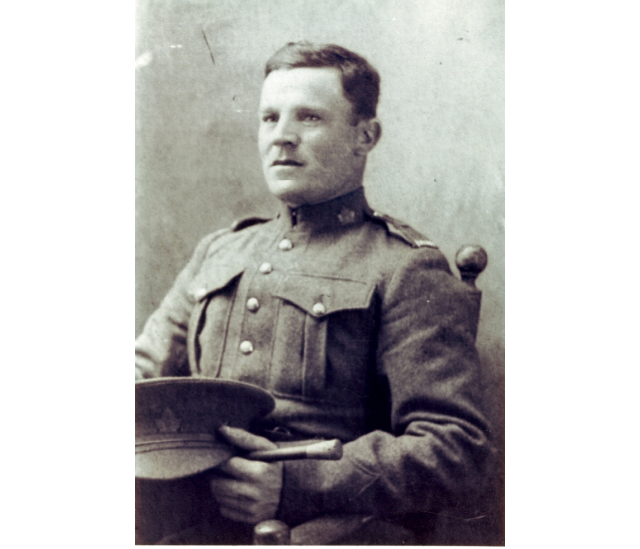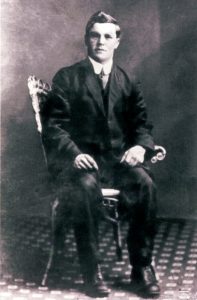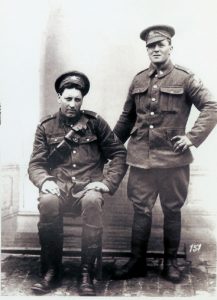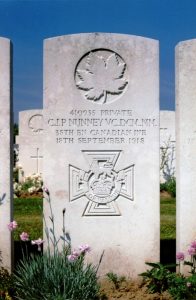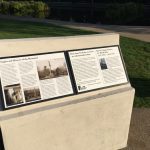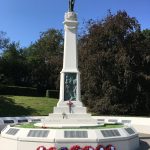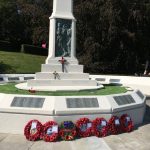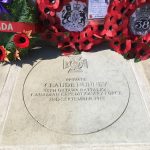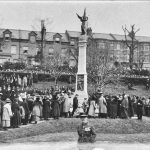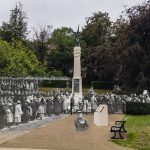Claude Nunney fought in the Canadian Expeditionary Force during the First World War and displayed ‘the highest degree of valour’.
Born in Hastings, at 42 Bexhill Road, on 19 July 1892 as Stephen Sargent Claude Nunney, he was generally referred to by his family as Claude. His father was William Percy Nunney, born in Burford, Oxfordshire, and his mother was Mary Nunney, formerly Sargent. Claude was the fourth of eight children.
The family left Hastings in 1895 and moved to Kentish Town, St Pancras, in London where his mother was to sadly die of food poisoning in February 1899. Two of Claude’s younger siblings died very young, and of the remaining six, five passed into the care of the Catholic Church. The three boys born in Hastings, Frederick George, Stephen Claude and Alfred Nunney all became “Home Children” in Canada. The term “Home Child” covered the young girls and boys sent as child emigrants by various agencies to Canada to start new lives.
Home children
Alfred and Claude Nunney travelled together aboard the SS Tunisian in October 1905 to Quebec and then on to St George’s Home at Hintonberg, Ottawa, Ontario. They were split up and sent to different families, Alfred moving to the Micksburg County, Renfrew, and Claude to North Lancaster. Alfred was just twelve and Claude thirteen when they went in their separate directions. Claude Nunney was placed with Mrs Donald Roy McDonald, where he lived and worked as a “Home Child”.
Unbeknown to Claude, his brother George, who travelled as a Home Child to Canada in October 1904, was drowned on 19 July 1908 in the Jock River, Jockvale. This is around 150 kilometres from North Lancaster. He was aged only 17. He had been placed with Patrick Houlahan, a local farmer.
Claude in the period 1913 and 1914 up to the outbreak of the First World War travelled to work in Trenton and St Catherine’s, Canada. He returned to the North Lancaster Township in early 1915.
At War
When Britain declared war on Germany on 4 August 1914, it was not a declaration limited just to the British Isles. All dominions and colonies of the British Empire were brought into the war as well; including Canada.
On the 8 February 1915, Claude Nunney attended the Drill Hall, Alexandria, Glengarry County. He was one of the very first to enlist into the newly authorised regiment in Ottawa, the Ottawa Overseas Battalion (Eastern Ontario Regiment), which was known as the 38th Canadian Expeditionary Force (CEF). He re-attested in Ottawa on the 8 March 1915. Nunney claimed to have been born in Dublin. Claude had no previous military service.
He was five foot six inches tall with blue eyes and red hair. The colour of his hair led him to be known by his fellow soldiers as “Red Nunney”.
The 38th CEF were sent overseas in August 1915, not to France as they wanted and anticipated, but to Bermuda, where they took over as the Garrison troops. Eventually in June 1916 the men of the 38th CEF landed at Plymouth and travelled to Aldershot. The 38th CEF joined the 12th Canadian Infantry Brigade, 4th Canadian Division. They underwent more training in preparation for the trench warfare across the Channel.
The 38th CEF embarked on 13 August 1916 to fight in France and Flanders, where they fought right through to the end of the war on 11 November 1918. The Ottawa regiment’s first large scale action was on the 18 November 1916 with the battle for the Ancre Heights, where they were involved in the fierce fighting for the Desire Trench, and had to attack across a sea of mud to get to their objectives.
Private Claude Nunney was involved in the heavy fighting to take the Vimy Ridge on 8 April 1917. He was sent with his Lewis Machine Gun crew to support Captain Thain McDowell. For the bravery shown that day Captain MacDowell was to be awarded the first Victoria Cross in the 38th CEF. Private Claude Nunney for his support of Captain MacDowell was awarded the Distinguished Conduct Medal (DCM).
Claude had been previously wounded in the left shoulder, before he went back into action with MacDowell. He received a second wound in his right leg. He was soon back with the 38th CEF by the 12 April. He was promoted to the rank of Sergeant in the weeks immediately after the Battle for Vimy.
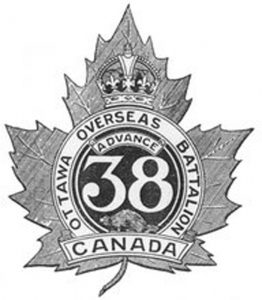
Badge of the 38th Ottawa Overseas Battalion – Image from ‘Soldiers of the 38th‘
After Vimy the fighting took the 38th steadily northwards toward Lens. They were ordered to attack Avion on 26 June 1917. They were in the front line for the next four days attacking the buildings on the outskirts of Avion. On the 28 June Claude Nunney went over the top and before he reached the enemy trenches Lt MacLennan, his platoon officer, had been wounded and he found himself in charge as the platoon sergeant. He was to be awarded the Military Medal (MM) for these actions.
The citation records he displayed the greatest energy strength and courage, on that day and in the subsequent two days. Claude also had assisted in the treatment and rescue of a wounded soldier, Private William Murray, who had been shot in the head by a sniper, when there were no stretcher bearers available.
Claude Nunney was gassed during German shelling on the night of 28/29 July 1917 and spent two months in hospital. He returned to his unit at the end of September 1917. He was attached to the Canadian Corps School, and remained with them for the next few months. Nunney was not with the 38th CEF when they fought in the Third Battle of Ypres.
By mid-April 1918 the 38th CEF were back in the Vimy area. Claude was to face a field court martial for striking a superior officer. On the 25 April 1918 he was found guilty. Whilst waiting to be transported to prison, he attempted with several other soldiers to rescue the pilot and observer from a German aeroplane that had been shot down nearby. He was to suffer burns to his face and hands. For his bravery he was to have his sentence suspended. But he did lose his Sergeant’s stripes, reverting to being a Private. Claude Nunney was able to re-join the 38th CEF on 18 August.
His brother Alfred Nunney was killed in action with the 44th CEF on the 10 August 1918 in their attack on Fouquestcourt.
Victoria Cross
The Canadian Army divisions were all heavily engaged in the heavy fighting that took place in the last 100 days of the war and the 38th CEF were as ever involved. Over the two days starting on the 1 September 1918, the Eastern Ontario Regiment attacked the well-constructed and heavily fortified defensive trench systems known as the Drocourt-Quéant Line at Dury.
Private Claude Nunney distinguished himself, as had been his habit throughout his time in France and Flanders, by visiting the various regimental outposts during the height of the fighting encouraging his fellow Canadian soldiers with his words as well as his example. His conduct was later described in the London Gazette on 13 December 1918:
Number 410935 Private Claude Joseph Patrick Nunney DCM MM, 38th Battalion, Eastern Ontario Regiment.
For most conspicuous bravery during the operations against the Drocourt-Queant line on the 1 and 2 September 1918.
On 1st September, when his battalion was in the vicinity of Vis-en-Artois, preparatory to the advance, the enemy laid down a heavy barrage and counter-attacked. Pte Nunney, who was at this time at company headquarters, immediately on his own initiative proceeded through the barrage to the company outpost lines, going from post to post and encouraging the men by his own fearless example. The enemy were repulsed and a critical situation was saved.
During the attack on September 2nd, his dash continually placed him in advance of his companions, and his fearless example undoubtedly helped greatly to carry the company forward to its objectives. He displayed throughout the highest degree of valour until severely wounded
On the 9 September 1918, Nunney was recommended by the British First Army for the award of the Victoria Cross for conspicuous gallantry during the operations to capture the German fortified trenches forming the Drocourt-Quéant Line.
Claude Nunney’s wounds proved to be fatal and he died on 18 September 1918. He is buried in the Aubigny Communal Cemetery Extension. Claude Nunney was one of seven Canadian soldiers to be awarded the Victoria Cross for the successful attacks on the Drocourt-Quéant Line.
Private Nunney was the mostly highly decorated other rank in the Canadian Army in the First World War, being the only Canadian soldier of the war to be awarded the Victoria Cross, Distinguished Conduct Medal, and Military Medal.
He was to be the 38th CEF second and final VC recipient. Claude Nunney was the only man born in Hastings to be awarded the Victoria Cross in the First World War.
Commemoration
On Sunday 2 September, Claude Nunney’s actions that led to him receiving the Victoria Cross were commemorated by the unveiling of a memorial paving stone in Alexandra Park, Hastings.
In attendance were the Lord Lieutenant of East Sussex, the High Sheriff of East Sussex, the Mayor of Hastings, the Chief of Staff of the Canadian Defence Liaison Staff, and Claude’s Great Grand Nephew Tim Nunney.
- Claude Nunney VC – Explanatory Plaque
- Claude Nunney VC – Commemorative Paving Stone
- Claude Nunney VC – Commemorative Paving Stone
- Claude Nunney VC – Commemorative Paving Stone
The Paving Stone was placed in front of the existing war memorial in Alexandra Park. The memorial was dedicated in 1922 and, to mark the commemoration for Claude Nunney, Kieron Pelling has created a stunning ‘then and now‘ photograph showing the memorial’s dedication and the site today.
- Dedication ceremony of Hastings War Memorial in 1922
- ‘Then and Now’ photo created by Kieron Pelling
After the ceremony, attendees gave the following responses.
Lord Lieutenant of East Sussex
I think everyone was moved by the organisation, dignity and poignancy of the occasion.
I know I speak for everyone who attended, and indeed the public in East Sussex in saying it was a great occasion and very fitting for Claude and his family.
Mayor of Hastings
I felt honoured to play a part in this event. Soldiers like Claude Nunney made the ultimate sacrifice for our country and its allies in the First World War, and it was right and fitting that we recognised this ‘son of Hastings’ with a permanent memorial in the town.
Captain Yvan Shank
This was a very touching service. It was the first paving stone ceremony of three that I am attending on behalf of the Canadian High Commission and it is very special this close to the 100th anniversary of the armistice to recognise these heroes that were awarded the VC.
Master Corporal Matty Ford
It was a very moving ceremony, particularly in the final year of the centenary and 100 years since the end of the war. It was a privilege to meet the family and a very powerful feeling to be speaking during the ceremony. This was not ‘just another speech’.
Tim Nunney
The Nunney family are all very proud and it has been a great honour to take part in such a moving ceremony.
As part of the commemoration of Claude Nunney’s life, Glenna Smith-Walkden from the Home Children Association produced the following poem, inspired by Claude Nunney’s life and his sacrifice for two nations:
British Home Children
We were British Home Children
Our families in Britain torn apart
Send them to Canada they said
for a brand new start
Canada needs help on their farms
We all benefit, what’s the harm?
We went to work as indentured labour
Most of us young chidren
Our employers did us no favour
We were housed and fed
Worked hard each day
Dreaming of Britain and our home far away
When our contracts ended we travelled to find work
Then the Great War came to the world
Thousands of us home boys bravely enlisted
Many saw it as a ticket home
And once there we would never again roam
Many died on the battlefields
To ensure freedom for you
Peace was once more with us
England it seemed no longer our home
Back to Canada we went without a fuss
To live our lives in our adopted new Land
But we are always British Home Children
Please remember us.
This story was submitted by Peter Silk who has extensively researched Claude Nunney’s life.

